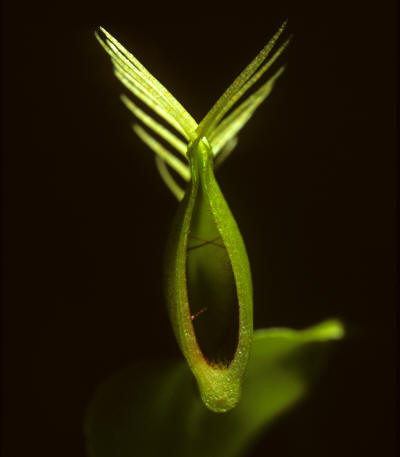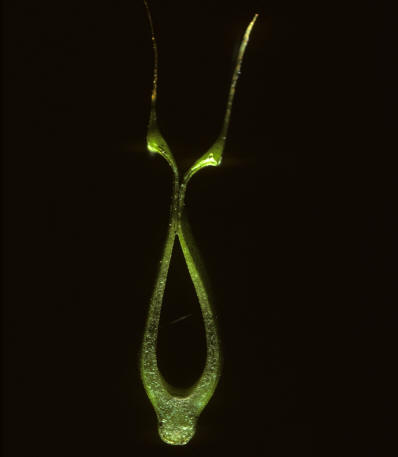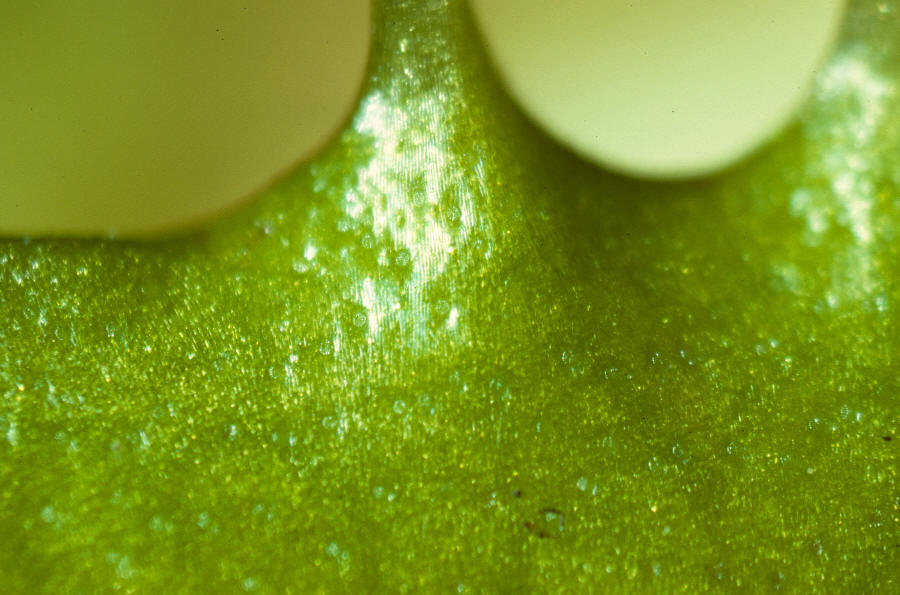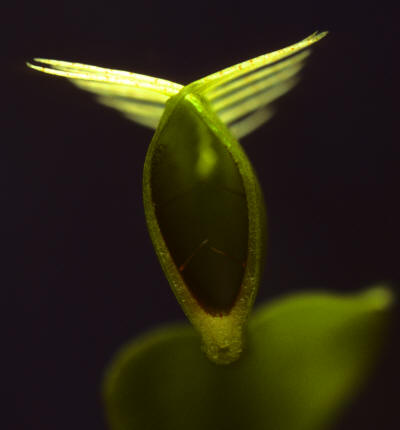| What's For Dinner? |
|---|
| If you want to see a Venus Fly Trap get its groove on,
check out this awesome clip.
Feed Me Making the Menu Since the Dionaea muscipula is immotile, it must develop a way to attract its lunch. One such aspect is the red coloration that intensifies from the sun. The more rays they catch, the more appealing they are to insects. Another attractive quality is found in the glands of the trap. The adaxial surface of of each trap consists of two kinds of glands. The first type is the alluring gland (shown directly below). These glands are colorless and are imbedded within the epidermis. Located on the outer margins of the trap, these glands produce a sugar with an appealing odor. These glands are 1/4 of a inch from the trigger hairs. This distance is important for the conservation of energy. While an insect is consuming sugar, it activates the trigger hairs if they are longer than 1/4 of a inch in length. The trap knows that it is large enough to receive sufficient nutrients, so the trap closes. Any insect smaller than 1/4 of a inch will not activate the plant to close. By having this feature, the plant will not expend energy on a wasteful prey.
The second type is the digestive gland. These glands give the plant the red coloration because anthocyanin is present in their cells. Anthocyanin is a water soluble pigment located in cell fluid. These cells are much larger and stand out prominently. (The photo directly below shows these digestive glands).
Closing Time The Dionaea muscipula is known from its characteristic trapping mechanism. In order for the trap to close completely and consume its prey, it must go through four different phases. To see the whole process take action, check out this amazing clip to see nature at its finest. Venus Fly Trap Takes The Stage The open phase acts as the appealer because of its red coloration and production of a sugary substance. In this phase, the adaxial surface of the trap possesses a convex curvature while its marginal spines are directed inwardly. The abaxial surface has a concave curvature (photo shown below).
The shutting phase is the initial closing of the trap, in which the marginal spines loosely interlock. This closing can take less than a second to occur. The spines form a cage and remains in this position for the duration of 30 minutes (shown below). This point is critical for the conservation of energy. Small insects have the ability to escape between the spines and saves the trap from wasting energy on a small insect. However, if the insect continues to touch the trigger hairs, the trap will continue to the narrowing phase.
The narrowing phase is the closing of the two lobes until
they are flattened against each other, with the exception of a small
area near the midrib. Nitrogenous bodies cause the flattening of
the lobes.
|
|
 Photo - Carnivorous Plant Dionaea by Makoto Honda |
 Photo - Carnivorous Plant Dionaea by Makoto Honda |
| The close phase is the point when the lobes are
completely flattened against each other (shown below). The
pressure is so powerful that the insect's body is crushed. During
this phase the abaxial surface has a convex curvature and the adaxial
surface possesses a concave curvature. All of the digesting occurs
at this point. The trap acts like an air tight temporary
stomach. The digestive glands secrete formic acid, which is a
colorless bactericide. This
acid drowns the prey if it somehow survived the narrowing phase.
The digestive glands absorb the soft parts of the insect, allowing only
the indigestible chitinous skeleton to remain. Digestion peaks at about
3-4 days. The trap remains closed for 1-2 weeks until digestion is
completed. However, if the insect is too large for the trap (more
than 1/3 its size), the insect can cope with the closing pressure and
subject the trap to bacterial decay. In about 2 weeks, the trap
turns black and dies instead of opening.
Leftovers The remaining chitinous skeleton eventually falls out of the trap by wind or some other external force. Each trap is able to catch prey 3-4 times. After these captures, the trap ceases to function. In addition, each trap is only allowed 8-10 non-feeding closures before it loses its function. There are factors that attribute to the speed of the shutting phase. The older the plant, the slower its speed. Also, the higher the temperature, the faster the speed. In fact, at high temperatures, it can shut in less than 1 second with only 1 stimulation of a trigger hair! This indicates another importance of the sun. |
|




